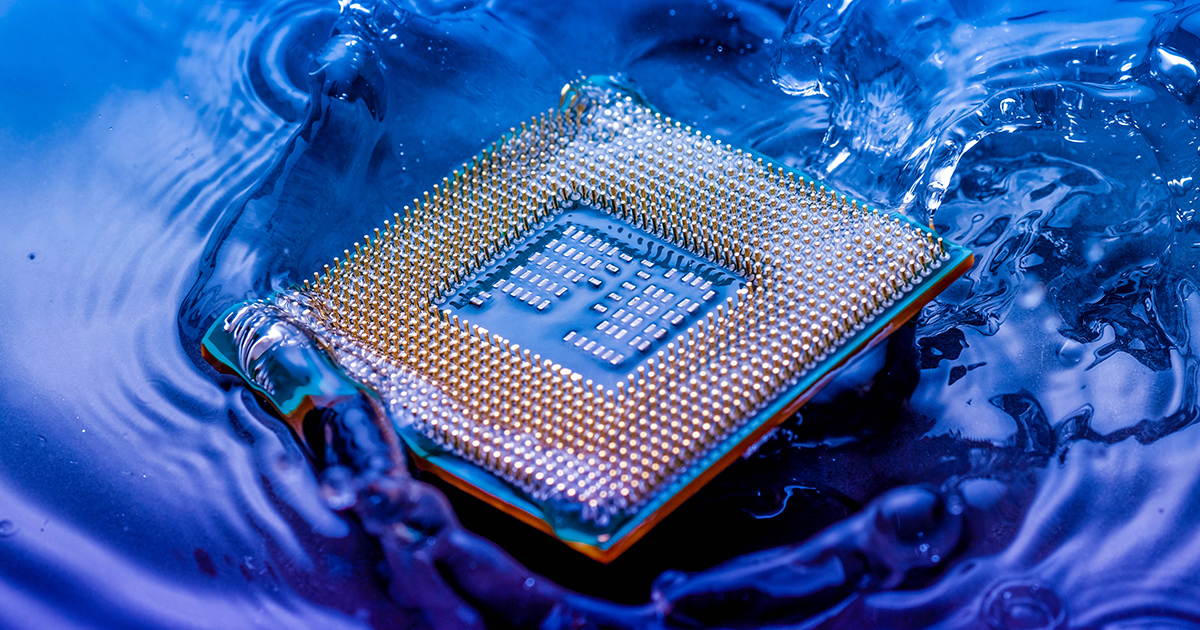The Secret to Expanding Semiconductor Manufacturing in the U.S.? Water

Silicon wafers and complex manufacturing equipment take center stage in chip manufacturing. However, another resource is just as important, but often overlooked--water. Chip fabs go through millions of gallons of water every day to cool machinery and ensure wafer sheets are free of contaminants.
As the U.S. pours billions of dollars into its domestic semiconductor industry, water availability and usage will take center stage. For both chip companies and cities hoping to attract their newest plants, investing in water-related infrastructure is key. Moreover, environmentally friendly management of this vital resource will play a large role in the industry’s future.
More Water Than a Small City
Chip production is the most precise type of manufacturing to ever exist. With EUV lithography shrinking operations down to the nanometer level, even the smallest contaminants—specks of dust or debris—can wreak havoc on a production line. So, chipmakers use ultrapure water, which has been filtered to remove contaminants as small as salt ions, to keep silicon wafers clean during fabrication. Water also plays an important role in cooling manufacturing equipment, though it doesn’t need to be ultrapure.
Given this intense demand, a single facility can go through millions of gallons of water every day. That’s about the same amount a small city would use in an entire year. This begs the question, where does this water come from?
In some cases, chipmakers work with the cities their fabs are located in to secure enough water for their operations. For instance, Intel is preparing to open a new $20 billion mega-plant in Columbus, Ohio. The city’s three existing water treatment facilities process 145 million gallons of water per day. However, Intel’s new plant will significantly increase the city’s water demand. As such, the local government now has plans to open a fourth water treatment plant in 2028 to support the new Intel site as well as its surging population.
In upstate New York, several water storage tanks, each holding 15 million gallons, are standing by in preparation for Micron’s upcoming $100 million fab.
Sarah Porter, director of the Kyl Center for Water Policy at Arizona State University said in an interview with Wired, “Local leaders need to engage in candid conversations with their city’s water resources staff and economic development staff to ensure that any new high-volume user is a good fit with the community.”
Indeed, discussions surrounding water resources are a key part of attracting chipmakers to invest. While chip companies are eager to take advantage of incentives in last year’s CHIPS and Science Act, the necessary resources must be present. Naturally, municipalities whose water infrastructure can support large-volume users become more attractive to chip firms looking to expand.
Other times, chipmakers need to build their own water facilities to support their operations. In Phoenix, Arizona, TSMC is building a new water recycling facility to complement its upcoming fabs in the area.
Responsible Water Usage
Globally, water usage continues to be a hot topic in areas affected by drought. Typically, discussions center around industries where water demand is more obvious, such as agriculture and power generation. But the semiconductor industry is also in the mix.
In the U.S., clashes between chipmakers and the public are less common given their relatively small presence. However, in Taiwan and Korea where chip fabs are everywhere, companies like TSMC have come under fire for their water usage. Local farmers have had their irrigation systems turned off amid droughts while chip factories continue to use millions of gallons of water.
Notably, this is a fine line that the industry will need to walk—particularly in the U.S. as the domestic chip industry prepares for a period of rapid growth. Expansion is generally viewed as a positive for the nation. But when resources become contested, attitudes often change quickly.
Fortunately, the chip industry has a lengthy track record of water conservation efforts. Recovering wastewater is one important method. While reusing water used in cooling is fairly straightforward, repurposing water that has been in contact with wafers during the manufacturing process is more complicated.
Wastewater from fabs contains a variety of dangerous contaminants, including hydrofluoric acid, silicon particles, and organic carbon residues. Each of these contaminants demands a different process for removal. Chipmakers who don’t have their own treatment plants often try to reuse contaminated wastewater for cooling.
Meanwhile, companies like Gradiant are developing specialized reverse osmosis processes to filter wastewater from the semiconductor industry. The company notes it has achieved a 98% water recovery rate with its proprietary membrane.
The importance of innovative solutions for water management will only grow in the coming years as demand for more chips leads to new fabs opening around the world. As the U.S. attempts to aggressively expand its semiconductor industry, it will be center stage for chip-related water discussions. Properly managing this vital resource must continue to be a key priority for the industry.











